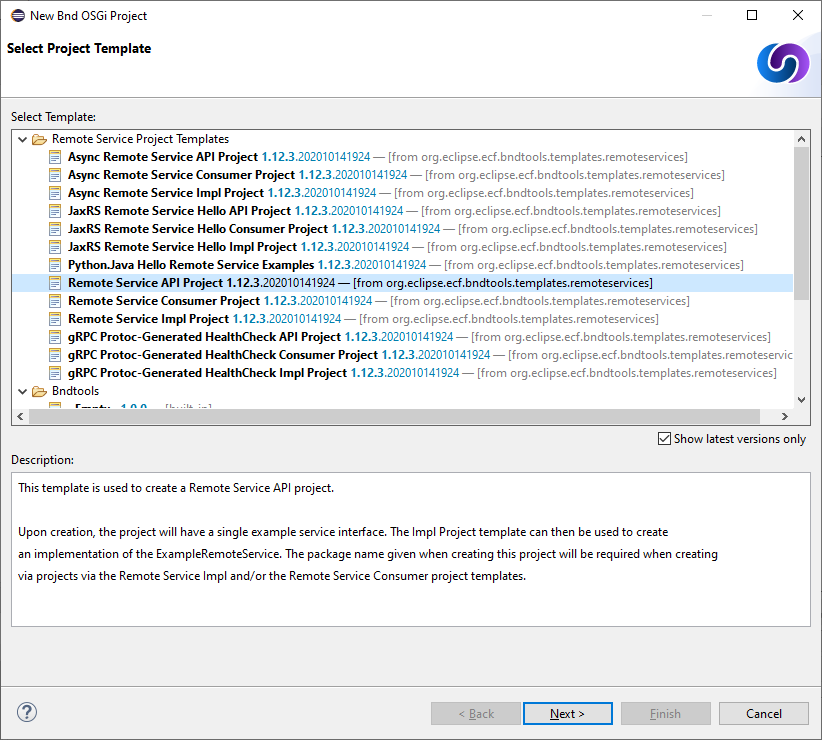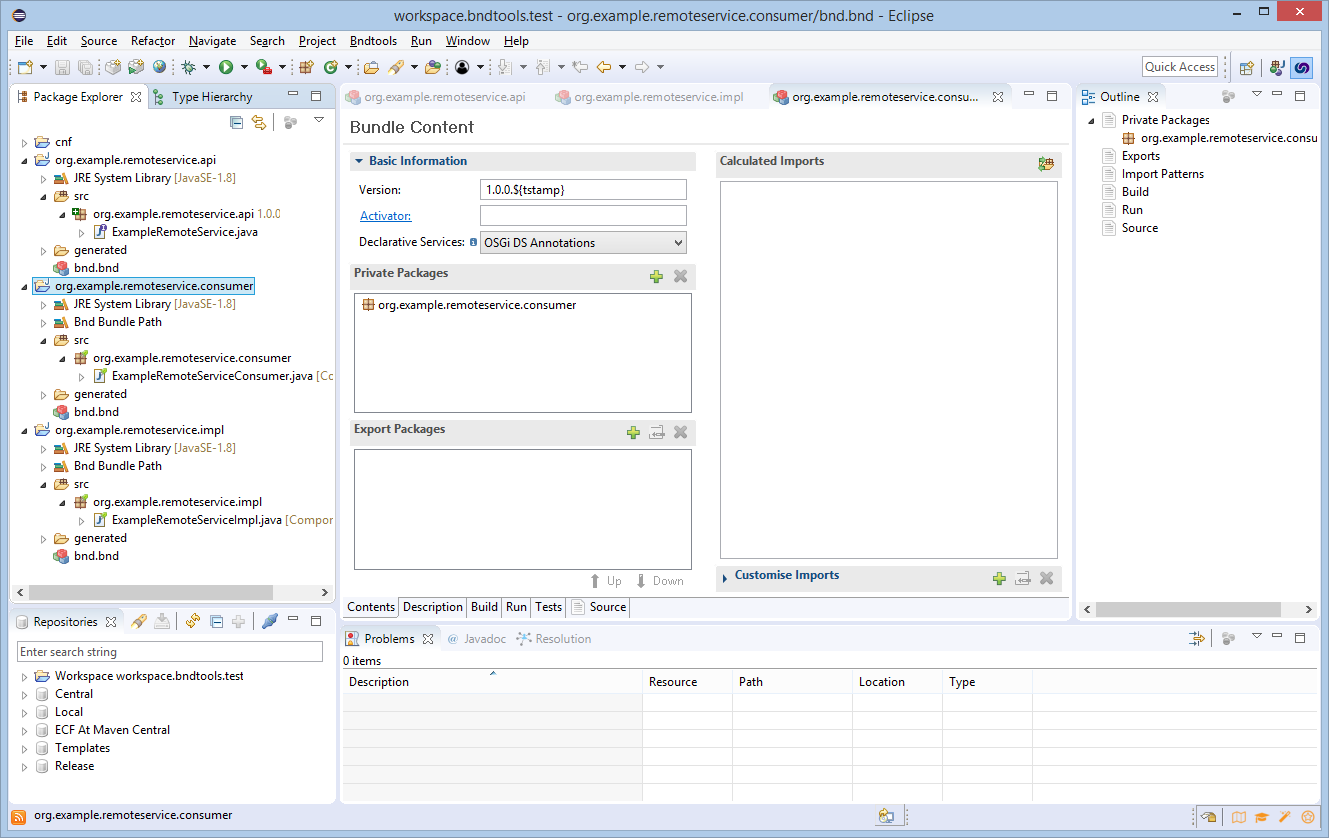Notice: This Wiki is now read only and edits are no longer possible. Please see: https://gitlab.eclipse.org/eclipsefdn/helpdesk/-/wikis/Wiki-shutdown-plan for the plan.
Using the Bndtools Remote Services Project Templates
Once you have created a Workspace using the Remote Services template, it's now possible to use Bndtools project templates to create a new remote service API project, create an implementation of this remote service, create a consumer of the remote service, and run/test the implementation and consumer.
Contents
Create a Remote Service API Project
In the new workspace there is a Remote Services API Project template to help create a Remote Service API project. To use this template, select File->New->Bnd OSGi Project
Select Remote Service API Project->Next
Project Name: org.example.remoteservice.api
Note: this is a suggested name for the example project, when you use this template for creating your own remote service you can specify an appropriate project/bundle/package name.
Choose Next->Finish. This will create a new project in your workspace named org.example.remoteservice.api
Create a Remote Service Impl Project
Select File->Next->Bnd OSGi Project->Remote Service Impl Project template
Project Name: org.example.remoteservice.impl
Select Next. Under Template Parameters for the apipackage parameter specify the name of the API project created above (e.g. org.example.remoteservice.api) and Next->Finish.
Create a Remote Service Consumer Project
Similar to the Impl project above, create a consumer project by selecting the Remote Service Consumer Project template.
Once all three (API, Impl, Consumer) projects are created, the workspace should look something like this
Create and Use Bnd Run Descriptor for Impl and Consumer
In the Package Explorer select the impl project (e.g. org.example.remoteservice.impl), and then File->New->Run Descriptor File (.bndrun). Select the ECF Generic Distribution Provider template->Next, and give an appropriate File Name...e.g. impl and Finish. Click Resolve under the Run Requirements section and then choose the Run OSGi or Debug OSGi icons in the upper right of the Resolve/Run. This should result in a Console opening and output similar to the following in the console
____________________________
Welcome to Apache Felix Gogo
g! 14:05:38.659;EXPORT_REGISTRATION;exportedSR=[org.example.remoteservice.api.ExampleRemoteService];cID=StringID[ecftcp://slewis-lenovo:54390/server];rsId=1
--Endpoint Description---
<endpoint-descriptions xmlns="http://www.osgi.org/xmlns/rsa/v1.0.0">
<endpoint-description>
<property name="ecf.endpoint.id" value-type="String" value="ecftcp://slewis-lenovo:54390/server"/>
<property name="ecf.endpoint.id.ns" value-type="String" value="org.eclipse.ecf.core.identity.StringID"/>
<property name="ecf.endpoint.ts" value-type="Long" value="1524171938628"/>
<property name="ecf.rsvc.id" value-type="Long" value="1"/>
<property name="endpoint.framework.uuid" value-type="String" value="45a4a861-3487-4089-a940-be622466a7bc"/>
<property name="endpoint.id" value-type="String" value="937b3136-0864-4e3b-bf87-0462502eb1a5"/>
<property name="endpoint.package.version.org.example.remoteservice.api" value-type="String" value="1.0.0"/>
<property name="endpoint.service.id" value-type="Long" value="64"/>
<property name="objectClass" value-type="String">
<array>
<value>org.example.remoteservice.api.ExampleRemoteService</value>
</array>
</property>
<property name="remote.configs.supported" value-type="String">
<array>
<value>ecf.generic.server</value>
</array>
</property>
<property name="remote.intents.supported" value-type="String">
<array>
<value>osgi.basic</value>
<value>osgi.async</value>
<value>osgi.private</value>
<value>passByValue</value>
<value>exactlyOnce</value>
<value>ordered</value>
</array>
</property>
<property name="service.imported" value-type="String" value="true"/>
<property name="service.imported.configs" value-type="String">
<array>
<value>ecf.generic.server</value>
</array>
</property>
<property name="service.intents" value-type="String" value="osgi.basic"/>
</endpoint-description>
</endpoint-descriptions>
---End Endpoint Description
This debug output indicates that the ExampleRemoteServiceImpl was exported by the ECF RSA implementation and is ready to be used by a consumer.
Consumer
Similar to the Impl described above, create a Bnd Run Descriptor for the consumer project, then resolve and Run/Debug OSGi.
If the Zeroconf discovery is enabled on your LAN, after a few seconds the following output should appear on the consumer's console
Welcome to Apache Felix Gogo
g! service responds=Hello ExampleRemoteServiceConsumer
14:08:52.185;IMPORT_REGISTRATION;importedSR=[org.example.remoteservice.api.ExampleRemoteService];cID=StringID[ecftcp://slewis-lenovo:54390/server];rsId=1
--Endpoint Description---
<endpoint-descriptions xmlns="http://www.osgi.org/xmlns/rsa/v1.0.0">
<endpoint-description>
<property name="ecf.endpoint.id" value-type="String" value="ecftcp://slewis-lenovo:54390/server"/>
<property name="ecf.endpoint.id.ns" value-type="String" value="org.eclipse.ecf.core.identity.StringID"/>
<property name="ecf.endpoint.ts" value-type="Long" value="1524171938628"/>
<property name="ecf.rsvc.id" value-type="Long" value="1"/>
<property name="endpoint.framework.uuid" value-type="String" value="45a4a861-3487-4089-a940-be622466a7bc"/>
<property name="endpoint.id" value-type="String" value="937b3136-0864-4e3b-bf87-0462502eb1a5"/>
<property name="endpoint.package.version.org.example.remoteservice.api" value-type="String" value="1.0.0"/>
<property name="endpoint.service.id" value-type="Long" value="64"/>
<property name="objectClass" value-type="String">
<array>
<value>org.example.remoteservice.api.ExampleRemoteService</value>
</array>
</property>
<property name="remote.configs.supported" value-type="String">
<array>
<value>ecf.generic.server</value>
</array>
</property>
<property name="remote.intents.supported" value-type="String">
<array>
<value>osgi.basic</value>
<value>osgi.async</value>
<value>osgi.private</value>
<value>passByValue</value>
<value>exactlyOnce</value>
<value>ordered</value>
</array>
</property>
<property name="service.imported.configs" value-type="String">
<array>
<value>ecf.generic.client</value>
</array>
</property>
<property name="service.intents" value-type="String" value="osgi.basic"/>
</endpoint-description>
</endpoint-descriptions>
---End Endpoint Description
Note the line in the output:
g! service responds=Hello ExampleRemoteServiceConsumer
This indicates that the remote service was discovered, the endpoint description imported, and the proxy injected into the ExampleRemoteServiceConsumer. Then the ExampleRemoteServiceConsumer.activated method was called by DS, which is implemented with a call to the ExampleRemoteService.hello remote service method.
Breakpoints can be set in the Impl, and/or Consumer projects to inspect what's happening at runtime. The example code can also be refactored/renamed/modified.


